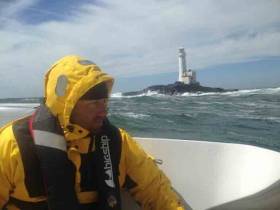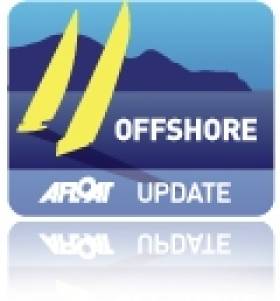Displaying items by tag: normandy channel race
Irish waters are the centre of attention for French offshore sailing fans today as the 12th CIC Normandy Channel Race races around the Fastnet Rock.
The five leaders in the 12th CIC Normandy Channel Race rounded Fastnet at dawn this morning. It’s the Franco-Spanish pairing aboard Redman (161) who were the first to reach the legendary lighthouse off the south-west tip of Ireland at 03 hours and 37 minutes UTC and switch back onto a course bound for the Scilly Isles and then on to Guernsey. Skippers Antoine Carpentier and Pablo Santurde del Arco are still leading the way now, but there is everything to play for at the head of the fleet given the tight bunching of the front runners. Polled at the Fastnet course mark, there was just one hour separating boat number 161 and fourth placed Lamotte Module Création (153). And the tension is set to rise aboard the Class40s…
 Purple arrows represent French Class40 yachts in Irish waters this morning. The boats are competing in the Normandy Channel Race
Purple arrows represent French Class40 yachts in Irish waters this morning. The boats are competing in the Normandy Channel Race
As forecast, the competitors were racing all night long in a E/NE’ly wind fluctuating between 10-12 knots with gusts of 20 knots. It resulted in the Class40s having to zigzag their way downwind along the coast of southern Ireland in a gybing battle to find the best strategic position, alternately closing on and distancing themselves from the Emerald Isle in a bid to hunt down some breeze, whilst trying to avoid punching into the current and cover their rivals. It’s a scenario that didn’t leave a great deal of respite for the sailors and is ongoing for the second and third pelotons of the fleet who are on the chase between the two Irish lighthouses of Tuskar and Fastnet.
Over the course of the day, the heart of a stormy low-pressure system rolling in from the south will cross paths with the competitors as they make towards the Channel Islands. The upshot of this little encounter will likely be somewhat reminiscent of the doldrums with no wind other than that produced by the storm clouds. The leaders will be the first to negotiate this particular weather phenomenon. Another tricky tactical section ahead then for the crews in this 2021 edition of the CIC Normandy Channel Race. Something to reshuffle the cards once more perhaps…?
Beating towards Fastnet Rock in Normandy Channel Race
It’s been a studious, laborious night for the 20 competitors still out on the offshore race track in the Normandy Channel Race. The SW’ly wind is right on the nose as they continue to battle towards Fastnet Rock after rounding the Tuskar mark yesterday afternoon. Twice the distance, three times the effort it is often said. Indeed, the Class 40s are embroiled in a series of tedious tacks upwind in a bid to make even minimal headway, with a heavy price to pay in terms of physical effort and strategic cogitation, with every sail manœuvre requiring a serious amount of stacking, which consists of shifting any movable weight in the boat to the other tack, from heavy sail bags to personal belongings. However, a sailor has a sense of humour and also knows a thing or two about philosophising, as evidenced by this short message from Halvard Mabire (Campagne de France) last night: “The work on deck is quite a laugh, but the shifting of gear down below is no joke, especially whilst the floor is constantly jumping around and moving. It’s easy to keep hitting yourself against the walls and bulkheads and taking a bath is out of the question, otherwise you’re at risk of setting the tongues wagging on the dock (because it’s common knowledge that nobody believes you if you say you’ve walked into a door to explain a black eye...)”.
After a quick exit from the English Channel and an ultra fast climb up to Tuskar, the race pace has dropped off considerably and the ability to make headway has greatly reduced. A firm leader, Imerys (Phil Sharp - Pablo Santurde), which has consolidated its lead overnight, (over 13 miles) has only covered 89 miles in the space of 24 hours in reality, or an average speed of less than 4 knots. The British-Spanish pairing is just 20 miles or so from the famous rock this morning, which it is likely to round late morning, before linking onto a rapid negotiation of the Irish Sea, beam onto what is set to be a W’ly wind. As is often the case, beating tends to reshuffle the cards and behind Imerys the battle for the top spots is fierce. Gambling hard, V and B (Sorel-Carpentier) has sacrificed her second place to hunt down a little more pressure a long way South, and with it a decent wind angle that will enable her to drive straight down towards Fastnet and hopefully be in with a chance of getting the better of Serenis Consulting (Galfione- Troussel).
With the passage shortly after 02:00 GMT this morning of Team SPM (Bry-Day), all the protagonists have now rounded the Tuskar mark and are making for Fastnet.
Ireland-Bound French Yachts Avoid Danger Off Dorset
#Offshore - A fleet of 20 French yachts racing to Ireland narrowly avoided sailing into serious trouble off the Dorset coast earlier this week.
As BBC News reports, UK coastguard authorities scrambled to warn the yachts via emergency broadcast that they were headed towards an exclusion zone set up for a live firing exercise at Lulworth Ranges.
"It looks like there was a slight error made by the French authorities," said a coastguard spokesperson, who confirmed that the yachts were diverted from their dangerous course after contacting the race director.
According to Practical Boat Owner, the yachts were competing in the Normandy Channel Race which began on Sunday 14 April and continues till this Friday evening.
The race route to and from Caen in northern France traverses a triangle across the Celtic Sea, past the most southwesterly tip of Cornwall, via Tuskar Rock and Fastnet Rock.
All Round Fastnet in Normandy Channel Race
Having tacked down the southern seaboard of Ireland after rounding Tuskar Rock, all boats in the Normandy Channel Race have now rounded the Fastnet and are heading east on the homeward leg. The Normandy Channel Race is one of many that visit Irish waters without stopping, with the Mini Fastnet and others dipping into our territory to find a high-profile rock before fleeing again.
The 8 competitors are making for the Scilly Isles, a string of rocks scattered about the South-West tip of England. To the great delight of these sailors, the fog, which has been tenaciously clinging onto them for the past three days, is gradually dissipating the further South the Class 40s sail. However, little else has changed and they’re still canted over against the wind as they make headway towards the English Channel and Normandy.
































































